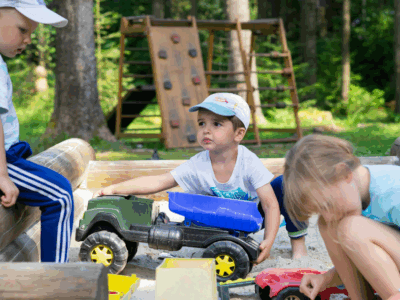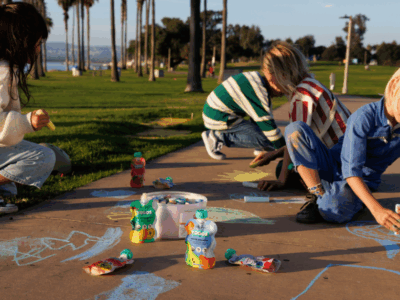Back-to-school season brings lots of feelings and a whole new set of firsts. It’s no surprise that parents start to feel the first-day jitters months before their kiddos set foot in their new classrooms, but there are lots of tried-and-true ways to calm those nerves (parents included!). Here are five of my favorite tips (and toys!) guaranteed to set everyone up for back-to-school success:
1. Get in the rhythm
During the summer months, make time to visit your child’s school to familiarize your little one with their new environment and to instill a sense of belonging.
- Make multiple visits before the first day of school to see how long it takes to leave the house and what traffic is like.
- Take advantage of this time to engage in conversations about your child’s school day, teacher, classmates, and some of the activities they might enjoy.
- Share your memories of preschool or kindergarten, focusing on the fun you had, the new friends you made, and the sense of confidence and independence you felt going off to school like a big kid.
These “mini drills” will allow your entire household to become familiar with a new routine and get your child excited about going to school.
2. Spark social skills
Sometimes being around new people and learning new rules can be hard. Playing games is a great way to cultivate confidence and get your child used to working in a social setting. Games teach kids at a very young age how to follow rules, take turns, share pieces and how to cheer each other on and win—or lose—gracefully.
As a former teacher and preschool parent, I’ve found that The Sneaky, Snacky Squirrel Game™ is a great introduction to game play. Simple rules and quick game play give little ones a chance to practice important social skills needed to grow friendships, regulate emotions and make smart decisions in a fun and playful way. PLUS, The Sneaky, Snacky Squirrel Game™ teaches color recognition, a key early learning skill, and matching, an important early math skill, using a unique squeezer tool that also boosts fine-motor skills. Win-win!
3. Build confidence with ABCs and 123s
Recognizing letters A–Z, numbers 1–10, and knowing how to count are the stepping stones for early reading and math skills. Practicing these foundational skills at home is critical to early academic success, but it doesn’t have to be boring or painful!
There are plenty of alternatives to pencil and paper or flash cards. One of my favorites is Hot Dots®! You can choose from tons of engaging, age-appropriate workbooks, each of which features an electronic pen that provides light and sound feedback for correct and incorrect answers. It’s the perfect blend of “you can do this alone, little one” and “pat yourself on the back, Mama” for engaging your child with important early learning skills. Best of all, these workbooks are easy to toss into a backpack for a fun summer travel activity and on-the-go learning!
Save 20% on select Hot Dots workbooks now through 7/31 with code 20HOTDOTS on Amazon!
4. Fine-tune fine motor skills
The small muscles in your kiddo’s hands play a BIG role in daily learning activities, from cutting with scissors or opening a lunchbox to grasping a crayon or pencil. The preschool years are when kids build the hand-eye coordination and fine motor skills they need for these activities and so many more. Hands-on engagement is the only way to build these skills, and providing a variety of activities will keep kids interested and engaged.
One of my family’s favorite ways to practice fine-motor skills (and the ABCs—BONUS!) is the Design & Drill® ABCs & 123s set. Busy builders can use a kid-friendly power drill (seriously!) and colorful bolts to practice letter and number formation, building their fine motor skills as they manipulate the tools. Now that’s what I call a learning drill!
5. Keep calm and activate the senses
When little ones engage multiple senses at the same time (touch, hear, look, etc.), they build nerve connections in their brains that help them tackle more complex tasks and problems—which is great!
But more importantly, this multi-sensory play is an amazing outlet for kids who are feeling overwhelmed, overstimulated, or just plain overwrought. Using their senses gives kids a grounded connection to the world around them, bringing them back into focus.
Introducing sensory play at home is simple—just find a quiet space and provide a single, unplugged activity that engages more than one sense at a time. Think sculpting compounds and doughs, books and building toys, and, of course, sensory bins. Providing your little one with the right sensory learning tools can help calm, soothe, and encourage them to become more aware of their mind, body, and feelings.
With a bit of thoughtful prep and fun family playtime, you can prepare your child for a comfortable, happy school experience. I believe in you!



